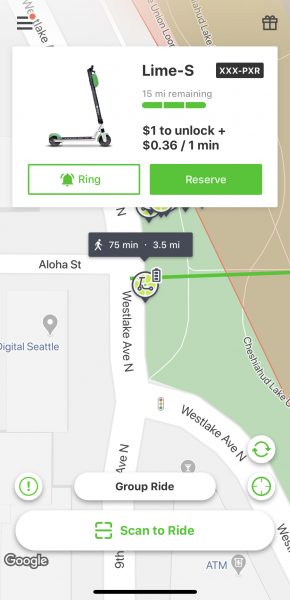 After years of talking, the first shared electric scooters are hitting Seattle streets today as Lime rolls out 500 of its popular Lime-S scooters.
After years of talking, the first shared electric scooters are hitting Seattle streets today as Lime rolls out 500 of its popular Lime-S scooters.
Lime has been serving Seattle for years with its pedal bikes and e-bikes. The company now owns and operates the red JUMP bikes available around town. Though the city has invited three companies to operate scooters in town, Lime was clearly in the best position to launch quickly.
“As Seattleites look to open-air transportation options that allow for social-distancing, shared scooters offer a reliable solution for short and medium-length trips, as well as for trips not served by public transit,” the company said in a press release. “The Seattle e-scooter pilot will help reduce car usage, augment transit and allow for safer and more sustainable travel.”
Their scooters cost the same as the JUMP bikes, with a $1 fee to unlock plus 36¢ per minute. While they are limited to only 500 scooters, the company is limiting their distribution efforts “from the Central District and SODO to Capitol Hill, Downtown, South Lake Union, Ballard, Fremont and the U District,” but users are able to ride them anywhere in the city that they want. Notably, this initial distribution area does not include West Seattle, though people can ride to West Seattle if they want to. Helping with the West Seattle Bridge transportation crisis was one reason the city cited during City Council debate over the permit plan. “As the fleet is authorized to expand, the deployment areas will expand,” the company noted in a press release.
It’s happening. #scooters@KIRO7Seattle @seattledot pic.twitter.com/r6v1D9f1ne
— Jonathan Hopkins 🚅🚇🚎🚲🛴🏳️🌈🇺🇦 (@JHopLovesTrains) September 16, 2020
In addition to Lime, SDOT has invited seated scooter company Wheels and LINK, which boasts a more burly scooter design they say can stop more quickly.
If your first scooter ride seems kind of slow, that’s on purpose. Part of Seattle’s permit requires companies to limit speeds on a user’s first trip to 8 mph, about half of the usual 15 mph limit. This is because injury studies found that a large percentage of scooter injuries occurred during a user’s first ever trip, so the city wants people to get used to how to handle them before the full speed is unlocked.
Lime claims that “99.985% of all trips over the course of a year were incident-free, with riders not reporting a single injury,” according to a press release, citing this Lime safety report. “This means that less than 0.02% of Lime scooter trips in the US resulted in a reported incident–of which 93% were reported as minor scrapes, cuts or bruises that did not require medical attention.”
Unlike the bikes, it is illegal to ride scooters on most sidewalks in Seattle. As we reported previously, this could prove a bit confusing to users since it is legal to ride on sidewalks if “there is no alternative for a motorized foot scooter to travel over a sidewalk that is part of a bicycle or pedestrian path.” This means they are legal on trails, in bike lanes and on bridge sidewalks that don’t have bike lanes (like the Fremont and Montlake Bridges). But there are a lot of other gray areas, and it could be problematic for people traveling in parts of the city that rely on fast streets with no bike lanes.
Lime does have a low-income program called Lime Access, which gives qualified users “5 free rides per day, up to 30 minutes each. After the fifth trip per day or after the first 30 minutes, Lime Access is priced at 50¢ to unlock and 7¢ a minute.” Anyone enrolled in SNAP, Medicare or ORCA Lift is eligible.








Comments
3 responses to “Lime launches scooter share in Seattle”
How will these be on the downhill? I bet you could go more than 8 mph on many of our Seattle hills.
“Notably, this initial distribution area does not include West Seattle, though people can ride to West Seattle if they want to.” Questionably not as notable, but the initial distribution area also does not include SE Seattle.
“Helping with the West Seattle Bridge transportation crisis”
How? where is one going to go for even $10 each way?
Ok, if one lives in Pigeon Point and works at say, Ash grove cement, it might only be about $3.50 each way, but how many people does that include?
“help reduce car usage” I don’t see that, I bet most trips will be just for the novelty, not replacing a car trip at all, for those trips that are utilitarian, I think the the number that are between “might as well walk” and “this is getting pretty expensive” is not going to be all that large. There will be some “I don’t want to wait for the damn Uber” but aren’t they competing with themselves in that case? Maybe not if the whole point is to show that anything but riding in an automobile is impractical and therefore Uber should be given carte blanche.